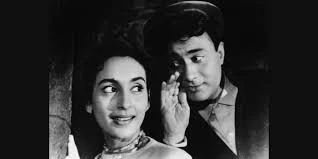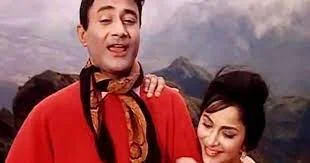Working hard on his screen image, styling himself after that
famous Hollywood actor, Gregory Peck, he finally hit success with the film Baazi
(1951) which was directed by Guru Dutt.
This was followed by another film noir, directed by the same
Guru Dutt, called Jaal (1952) which was a super-hit. And the movie-goers
of that age went crazy at that young man in a chequered jersey strumming guitar
and lip-syncing to the lyrics penned by Sahir and sung by Hemant Kumar in his seductive
voice, Yeh raat yeh chaandini phir kahaan (where will we find this night
and this moonlight again) / sun ja dil ki dastan (Listen now my heart’s
story). As he went on singing, pedon ki shaakhon pe soyi soyi (On the
branches of the trees the moonlight slumbers) / tere khyaalon men khoyi
khoyi chaandani (in thoughts of you, the moonlight wanders), no wonder, if
the listeners lost themselves in that laharon ke … dhima dhima rrag …soft
melody of the waves.
And, that singer on the screen, known as Dev Anand, became
the superstar of Hindi films, indeed, won the hearts of three generations of
cine-goers with his charismatic persona that shined through his trademark black
suit, his tilted head gesture, and a glint of mischief in his eyes—all of it cumulatively portraying
him as a flamboyant romantic star.
As the admirers are celebrating Dev Anand’s birth centenary (26
September 1923) across the country, droves of his memories hover around us. It was with films such as Taxi
Driver (1954), House No 44 (1955), Funtoosh (1956), Nau Do
Gyarah (1957), Kala Pani (1958), Kala Bazar (1960), Hum
Dono (1961), Tere Ghar Ke Samne (1963), Guide (1965), Jewel
Thief (1967), Tere Mere Sapne (1971) and Hare Rama Hare Krishna
(1971) produced by Nav Ketan films— the production house that he co-founded with his
elder brother Chetan Anand—that he gained fame as an incredible actor.
Film by film, song by song his mannerisms, his haircut, his wonderful wardrobe, flowing
scarf/muffler around the neck, striped shirts with stiff collars, corduroy jackets,
pants exhibiting the socks that would sure look absurd on any other body … his
romancing with beautiful heroines … in his careening gait with an odd drawl in
his rapid-fire delivery of dialogues … his unique way of nodding his head …
twitched lips … singing and swaying all around the heroine in his inimitable
style … passionately romancing with eyes … Aankho hi aankhon mei ishara
ho gaya … the utter charm of all that had made him the darling of the
urban youth.
Can we ever
forget Dev Anand who sang for us “Jaaye to jaaye
kahaaan (If I must go, where could I go?)/ samajhegaa
kaun yahaaan dardabare dil ki jubaan (who here will understand the
words of a heart full of pain?) pouring out the lamentations of an anguished
heart that sadly confesses as though suddenly remembered the lover’s plight,
Un kaa bhi gam hai apna bhi gam hai (She has her sorrows, I have my
own)” and this double whammy made him lose all the hope as is
reflected in his cooing, “ab dil ke bachne ki ummid kam hai (now
there is little hope of saving my heart).” Even today, whenever the song is heard,
we get to wonder how, of all … Dev Anand, putting aside his signature bubbling
energy, crib like that subjecting every spectator … his fans … to bekhudi …
Look, when the
beseeching and contrite Madhubala gives up in Kalapani and seeks pardon
… Achha ji main hari chalo maan jaao na … the hurt lover in Dev
teasingly expresses his masti thus … dekhi sab ki yaari mera dil
jalaao na … and no amount of her wooing … dekho dil na
todo could lure him … so goes on he … chhodo haath chhodo … …How
sweet of him!
How
mesmerizing it looks when Dev Anand, with a blazer on the shoulders … serially
nodding his head …winking his sparkling eyes … steps down the Qutub Minar,
caressingly hiding Nutan’s charming face from others’ stares, and who could
refrain from joining him to hum … Dil ka bhanwar kare pukar / Pyar ka
rag suno...?
Or, who could
forget the scene where he, stylishly leaving the Lambretta on the road and with
tweaked legs, walks on Shimla roads … calling for Nutan … Tu Kahaan, Ye
Bata, Is Nasheelee Raat Mein , Maane Na Mera Dil Deewaana, Haay Re, Maane Na
Mera Dil Deewaana … throwing the hat into the air—another hallmark of
Dev, to vent out his depression or to let his elation known—and running after
it to catch … …?
How
could anyone forget his running in the wilderness on the moonlit hills … ...
all his limbs … why the whole body … swinging in its own harmonic disharmony
… ... perhaps, intoxicated by love … … but in sync with spectators’
expectations … ..... throwing his hat
all around in gay abandon and singing liltingly … O ho ho ho, khoya
khoya chaand, khula aasmaan / Aankhon mein saari raat jaayegi / Tumko bhi
kaise neend aayegi … or ... ... his sitting in the lower berth of the
Ooty-bound train and questioning Waheeda .....teasingly ...Uparwala jaan ke
bhi anjan hai, to the accompanying hissing and whistling of the steam
engine amidst the night’s silence?
When
Kishore pours out his heart longingly in Gaata rahe mera dil and
Dev Anand lip-syncs, while Waheeda crawls behind him leaning on his shoulder,
every spectator lived the rapacious … youthful … romantic moment for himself or
herself … along with Dev Anand … and when he cried … Kya se kya ho gaya
tere pyar me, every spectator’s quivering heart rocked in his/her throat …
Who
can forget Dev’s dialogues preceding the song “Din dhal Jaaye haye raat na
jaaye”? in Guide:
Dev: “Kohi
Hai”, in his usual style.
Boy: “Kya
baat hai sir, aaj aap bahaut pee rahe hain?”
Dev: “Zindagi
bhi ek nasha hai dost. Jab chadhta hai to poocho mat kya aalam rehta hai… lekin
jab utarta hai, in his usual rat-a-tat style
This
sets the mood of the listener and prepares them for the song that follows. This
hypnotic song begins with a soft alaap … Hmmmmmm … Din
dhal jaaye haye, and the hallmark of the song is the way Rafi
renders haye … then, like its parent raga
Yaman-kalyan, the song flows to fathomless bottom to quarry viopralamba
shringar, duly supported by matching lyrics: Dil ke mere paas ho
itne phir bhi kitini door (You are so close to my heart and yet so far
away) / Tum mujh se main dil se pareshan, dono hai majboor (You’re
troubled by me and I’m troubled by my heart, both are helpless) / Aise mein
kisko kaun manaaye (In such a situation, who can comfort whom) … The
lyrics delivered in a very low voice by Rafi to the accompanying Burmanda’s
equally soft orchestration, particularly flute … all cumulatively make the
listener go along with Dev in the same mood …. The extraordinary impact of this
song is certainly more due to Dev’s underplaying that elevated the depth of the
simplest words chosen by Shailendra that convey the mysteries of life very
effectively.
Besides
all these yaadein … droves of his memories that hover around us, seasoning
pleasure with pain, there is certain something in Dev Anand’s personality that
is pretty inspiring. His love for Suraiya that knew no bounds is fresh in the
minds of people even after six decades. In one of the interviews, he spoke of it
thus: “I loved her. She loved me back. More
than physical, it is the beauty of the imagination of being together, thinking
about each other … holding hands … secret meetings in places no one could
guess… whispering sweet nothings … great days, great moments … I could not
marry her. It made me mad. I was dejected. And I cried … & sobbed.” Once
turned down, he said, “I have forgotten it. I got out of it.” What a maturity!
Indeed, he claims to be intelligent, creative, forward-looking and never
cribbed at the past. That’s what Dev Anand was.
Putting on the military uniform… walking in the jungle, half skip and jumping from one stone to the other … puffing a cigarette …as he sang that wonderful song —“Main jindagi kaa saath nibhaataa chalaa gayaa (I just kept going with the flow of life), / Har fikr ko dhuein mein udaataa chalaa gayaa (Kept blowing away every worry like smoke) / Barbadiyon ka sog manaanaa fijul thaa (it was useless to be sad about whatever gone wrong) / Jo mil gayaa usi ko muqaddar samajh liyaa (Whatever I got, I considered that as my fate) / jo kho gayaa main us ko bhulaataa chalaa gayaa (whatever I lost, I kept going, forgetting it..)— forgetting the past, he secretly married Mona (Kalpana Kartik) in the lunch break of the shooting of Taxi Driver, which he described as “the greatest moment …”
Thus, cheerfully accepting whatever that life has given, he moved forward with an eye on tomorrow— a tomorrow where no difference is felt between sorrow and joy (Gam aur khushi mein fark na mehasoos ho jahaan) and kept moving to that point of no difference—(Main dil ko us makaam pe laataa chalaa gayaa). What a romantic association with philosophy!
Yet, this young, stylish, sophisticated octogenarian said that he kept on crying for the second time in his life when the marriage of his ‘darling’ daughter broke. He said in an interview: “It was painful for me… these youngsters get married in a passionate fit of decision & they regret it later”. But he also said, “my sorrow was short-lived and told himself, ‘Common, this is part of life, who knows this may lead to some good?’” He said one must put aside the sorrows and keep on marching forward. He said he would never get tired. Full of energy— “na dukh na sukh hai, na din hai na duniya, na insaan na bhagavan sirf main, main, main hoon” —and this mature man kept on moving forward with no baggage —“Har fikr ko dhuein mein udaataa chalaa gayaa” (Kept blowing away every worry like smoke). There is perhaps, something in that philosophy for one to pick up ….
**




No comments:
Post a Comment